You’d think after three days of crazy rocks in Cappadocia that I’d head for some place where the main tourist activity was something other than looking at crazy rocks. Well you’d be wrong! Pamukkale (pam–oo-kuh–lay) is know for one thing:
They’re shapely deposits of minerals (mostly calcium I think) that have formed into lovely terraced pools over the last few thousand years. They cover the snow-white hillside just outside the town, and have done since before Roman times. It’s a real tourist attraction, and quite cool to see.
I got an overnight bus (again...) and arrived at about 6:30am in Denizli, then had to take a servis to Pamukkale. The bus system in Turkey is really quite advanced, though slightly opaque for the uninitiated. (I’ve come to the conclusion that you just have to put yourself in the hands of whatever friendly Turkish person you can find, and trust that they’ll point you in the right direction. So far, this has worked.) The buses go just about anywhere, but you have to be prepared to do things in a few steps. For instance when I was leaving Göreme I had to catch a small bus from the centre of town to get to the large otogar (bus station) in Nevshehir. Then I got on the big overnight bus to Denizli. I got off that bus at Denizli and looked around for a servis – another of the small buses. I can’t tell whether these servis are run by the bus companies, our by tour companies, or hotels, or what, but they’re always there. The one I ended up in seemed to be run by an enterprising guy with a tour company, because he tried to sell me an all-day tour of Pamukkale after he dropped me at my hotel. (He also sang Korean folk songs during the drive. At one point during the serenade I turned to my Australian seatmate and said, “At times like this do you ever wonder how, exactly, you came to be sitting in a minibus in Pamukkale at 6:30 in the morning, with a Turkish driver singing in Korean?”)
I rebuffed the offer of a tour (“Normally 50 lira, but for you I make special price only 40 lira, includes lunch. You come.”). I’d just spent the previous two days on all-day tours around Göreme, so I was ready for a day of solitary, self-guided, unhurried sightseeing. More pressingly, I was ready for a two or three hour nap before venturing forth. A 9:30 am tour was simply not an option.
So I had my nap, and a nice Turkish breakfast at the hotel, and headed off at the crack of noon. You approach the site of the travertines on foot from the town, and walk up a long slope to the ticket office where you pay 20 TL and are instructed to take your shoes off once you get to the travertines. It’s a bit of a rough go for tender, shoe-coddled Western feet, and there’s water everywhere. Luckily the water is quite warm and it’s not a long walk. In summer the place is apparently heaving with tourists, who actually bathe in the pools. The LP has a charmingly snarky comment on this subject:
“You’ll also notice an influx of day-trippers – mainly Russians – who regard it as appropriate to wander around the travertines… in skimpy bathing attire. Personally, we’d like to see Pamukkale’s whistle blowing security police also adopt a wider brief as fashion police.”
(Having experienced the Ample-Russian-Man-in-Skimpy-Bathing-Suit phenomenon in August, I say Amen to that, brother!)
I made it to the top without incident, and got a friendly German tourist to take my picture, as per Rob H’s instructions:
Seeing the travertines and photographing them is lovely, but only takes about half an hour. Luckily, I lied when I said Pamukkale is known for one thing. It’s actually known for two things: the travertines, and the ruins of a Roman spa town of Hieroplois that grew up around them. The top of the calcium-coated cliff is covered with extensive ruins, some well-preserved and reconstructed, some mere piles of rubble (more rocks!). I thought the best thing about the whole site was that you could go anywhere. Unlike similar sites where barriers and fences and gates prevent you from getting up close and personal with the rocks, Hieropolis was like a big park. There were beaten paths running all through the ruins, and only one or two places that were blocked off, presumably for safety reasons.
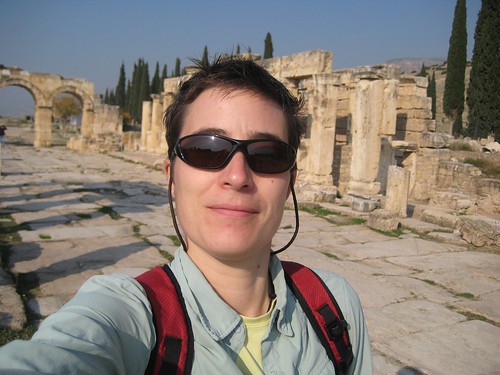 Here I am on Frontius Street (Rob: two people pictures in one post!)
Here I am on Frontius Street (Rob: two people pictures in one post!)
I’m not sure this is the best way to preserve the site, but it made for a fun afternoon of rock-hopping. Also, if I’d been in a more larcenous frame of mind and possessing of a larger, sturdier backpack, I think I could have walked off with any number of bits of worked stone. (Note to Karen: Please expect a large, heavy package to arrive in the next 10-14 days. If anyone official asks what’s in it, it’s 37kg of Turkish Delight.) Anyways, it was great.
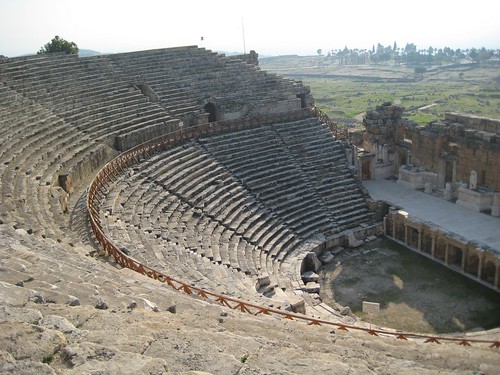 Fantastic theatre where I stopped for a snack and a bit of cryptic crossword puzzling
Fantastic theatre where I stopped for a snack and a bit of cryptic crossword puzzling
Ok, I lied again. Actually, Pamukkale is known for three things: the travertines, the Roman ruins, and the still-active hot springs that you can bathe in. It’s a trifecta: crazy rocks, Roman ruins and swimming! The cost to swim in the antique pool was a steep 23 TL, but I went for it anyways. The water was pleasantly warm, though not hot, and the pool was dotted with submerged bits of broken fluted columns and such, which made for an interesting swim. It’s not often you get to float in a natural mineral spring with your butt parked on a thousand-year old chunk of Roman rock.
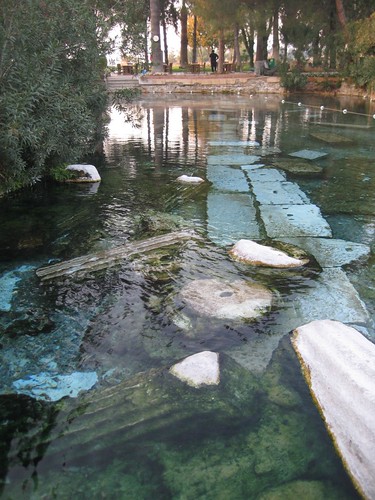 Here’s the pool. No picture of me in it, sadly, though I did appear in the vacation photos of scores of other people who were too craven to come in themselves.
Here’s the pool. No picture of me in it, sadly, though I did appear in the vacation photos of scores of other people who were too craven to come in themselves.
And that was Pamukkale – one very pleasant, relaxing day. The next morning I got on another small bus for the relatively short (4-hour) hop to Selçuk, home base for exploring yet more Roman ruins – the great city of Ephesus, or as it’s known in Turkish: Efes.
The bus ride was a bit cramped, mostly because it was the day before the start of the biggest holiday of the year here and lots of Turks were traveling to be with family for the four-day holiday. Open your hymnals to page 664:And different it was. I didn’t see any sacrifices, but it was only Kurban Bayrami Eve. However, on the bus to Selçuk I saw lots of pickup trucks go by with sheep in the back. And I saw people leading sheep on ropes down the streets. I even saw one stuffed into a hatchback. In a couple of places we passed through there were big corrals of sheep in the centre of town, and families picking them out to take home. It occurred to me that these were roughly analogous to the neighbourhood Christmas tree lot. It was a bit surreal, and lots of the Turks I’ve met subsequently say they’re not fond of the practice at all. It seems to me that there must be a way of making a somewhat more symbolic sacrifice that doesn’t necessitate hosing down the backyard patio when it’s over, but perhaps that’s my western-centric-ness showing.“The most important religious and secular holiday of the year, Kurban Bayrami (Festival of the Sacrifice) is as important to Muslims and Christmas is to Christians. The festival commemorates Ibrahim’s near-sacrifice of Ishmael…
Every year around four million cows and sheep are sacrificed for Kurban Bayrami. Traditionally, every head of household who can afford to buys a beast to sacrifice. Immediately after early-morning prayers on the first day of the holiday the animal’s throat is slit. It’s then flayed and butchered, and family and friends prepare a feast. Part of the meat is given to the needy; the skin is donated to charity, which sells it to a leather products company. These days you won’t see the sacrifices in the cities, but out in the countryside it’s a different story.”
Regardless, I fetched up in Selçuk in the early afternoon, and made my way to the very friendly Homeros Pension. There I met my new Turkish friend Osman, who I’d almost run into on my walk from the bus station. He was driving down a street that I’d blindly plunged into (Roman-style) and stopped short of running me down. A few minutes later, there I was in the pension, and it turned out that he spends a lot of time there too, helping out the family that runs the place. I played some friendly backgammon with him that afternoon, and he beat me 3 games to 1. Later that evening I got my revenge when I beat him in 5-2 (including one double game).
It turns out Osman runs a carpet shop, though he was not even close to being the stereotypical annoying, aggressive carpet-seller type that are thick on the ground in Istanbul. I did NOT buy a lovely striped kilim from him, but would recommend that if you’re in Selçuk and in the market for a nice Turkish carpet or kilim you could do a lot worse than visiting my friend Osman at Sultan Carpet and Kilim.
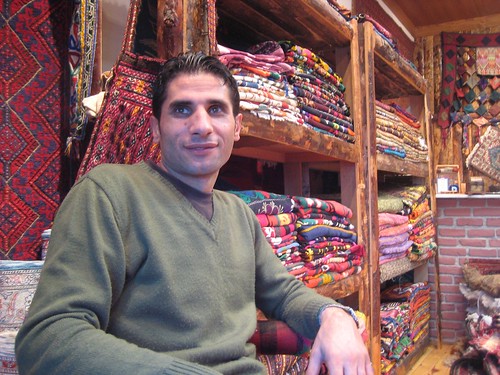 Osman, in his shop (Three! Count 'em THREE people pictures!)
Osman, in his shop (Three! Count 'em THREE people pictures!)
I was ostensibly in Selçuk to see the ruins of Efes, but I have to admit to feeling a serious case of ruin-fatigue by now. In fact, I’d say that Roman ruins have now joined the list of things I am DONE with. (Also on that list: most churches, all Madonna and Childs, and pretty much any archeological museum). Still, it was a sunny day, and the site is impressive.
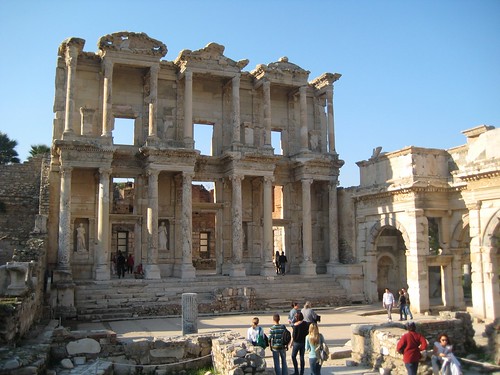 The most famous bit at Efes – the Library of Celsus
The most famous bit at Efes – the Library of Celsus
It turns out that Efes was a mere side-note to my trip to Selçuk. The best part was hanging around in the pension where I had an excellent, generous, mama-cooked supper both nights I was there (with home-made baklava!). It was such a comfortable, friendly place that both nights I ended up chatting with the other guests during dinner, which was really nice. And of course it was lovely meeting Osman, and playing backgammon with him, and letting him open up half the carpets in his shop in an attempt to divine my tastes, though we both pretty much knew I wasn’t going to buy anything. All in all, Selçuk and Pamukkale were both great stops, and I was sad to get on that last overnight bus for the long road back to Istanbul. But off I went, so get ready for some more posts on Turkey because I'm not done yet.

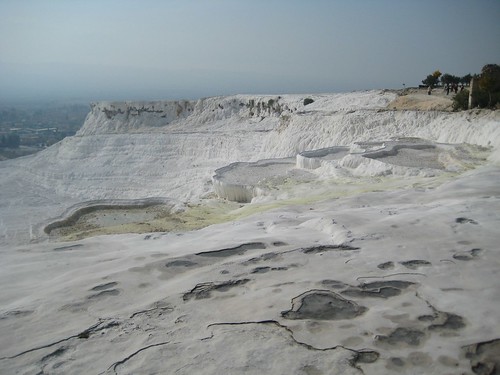
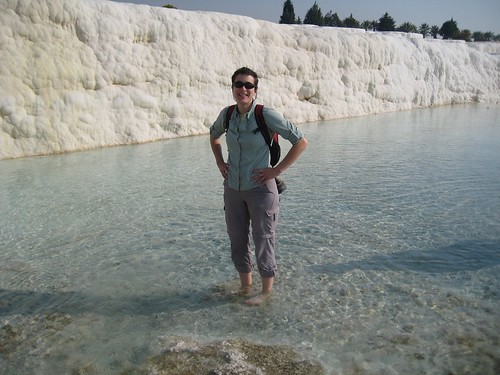


9 Comments:
Good, good...love those people pics.
One of your best postings to date.
Rob H.
The Travertines look suspiciously like a moonscape. It's interesting to note that I didn't know that our planet had so many of these cool rock formations...
Great people pics too!!
Turkish delight...ok, but I'm on to you.
Jeez Karen, shut up!
I love that you saw them throw a sheep in a hatchback! When I was in greece, we saw a guy get out of a honda civic hatchback and take a goat out of the "boot" (trunk of course!) and we thought it was a top 10 hilight of the trip. Where else would you ever see that happen.
I would see the same thing in Dubai - at Eid there would be sheep tied up in the hovels where the slaves live across from the big expensive hotels (have I mentioned how much I hate Dubai lately?) and then all of a sudden there wouldn't be sheep tied up. Yikes.
Great postings on Turkey. Glad you went to the "Library" - I am living vicariously through you.
IF you send Turkish Delight home (this IS your home because WE get your mail and to your dirty work) I guarantee it will not be here when you arrive. I also will be thoroughly disappointed if you did not sent a package containing said delicious treats...
Pam,
Sorry to hear you are under the weather. Get well soon.
Best Wishes from your Fans.
Rob H.
Turkish men are delightful but can be a bit too cloying and too sweet.
Post a Comment